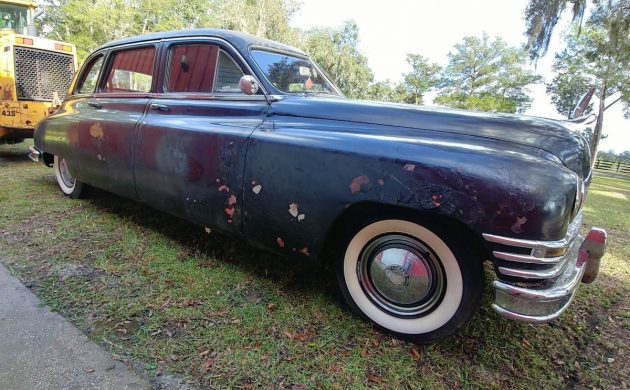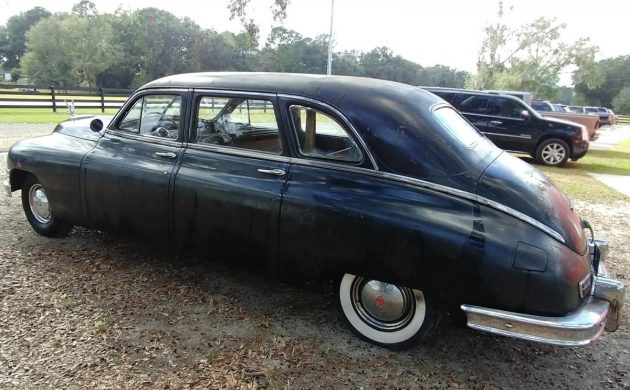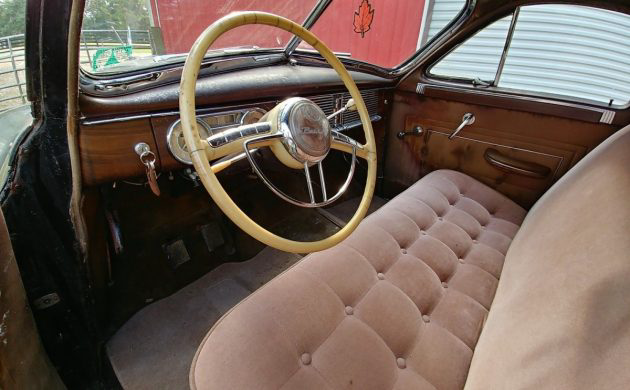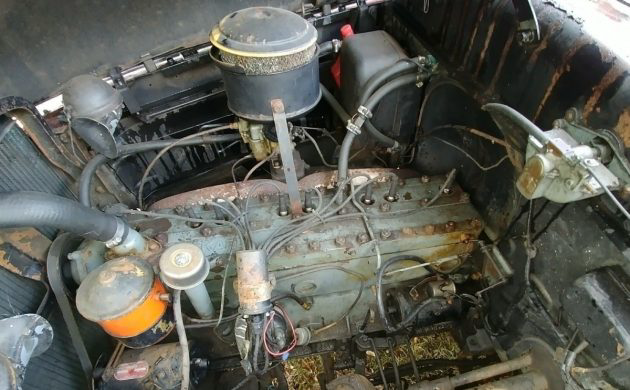What an amazing car, a big car, a luxurious car, an important car, a beautiful car, a long car and all kinds of additional descriptive terms could be used to talk about this 1948 Packard Super Deluxe Eight 7-passenger sedan. This super ride can be found here on eBay in Archer, Florida. The seller has it listed for $8,800 or you can make an offer.
The seller lists this beautiful car as a Super Deluxe Eight Limo but it could be a Super Deluxe Eight seven-passenger sedan, too, I admit to not knowing the exact differences between a seven-passenger sedan and a limo other than more luxurious interiors? Anyone? The seller says that there is no body damage, no bodywork and no bondo! It does have a bit of rust around the wheel well in the trunk – I’m assuming the spare tire well? – and a couple of tiny holes in the floor but that’s it. This isn’t a car that you’d want to take to a splash-and-dash paint shop down the street, this car was about as nice as it got in the late-40s.
This Packard Blue Metallic car actually looks quite restorable and a car like this one, in my opinion, really should be restored to look like new again. Again, I’m not positive what this car actually is, a Super Deluxe Eight Limo, a Super Deluxe Eight Seven-Passenger Long-Wheelbase Sedan, a Super Eight Deluxe, etc. One of you will know. Howard? The VIN starts out as 2271 which would be a Super Deluxe Eight Seven-Passenger Long-Wheelbase Sedan if I’m correct.
As outstanding and impressive as the exterior is, the interior is where the magic happens. Look at this thing! Gorgeous. This is a three-speed column-shifted manual and you can see that a few things could use some help. Windlace is available and hopefully you know of a great upholstery shop that can redo the door cards/panels and whatever needs reupholstering in there. The back seat area is amazing. I have always wanted a car with jump seats. I don’t know why, 90% of the time it’s just me in my vehicles so why would I need room for six other people?
This should be Packard’s 327 cubic-inch straight-eight with 145 hp and 267 ft-lb of torque. It took 17 seconds to get this car up to 60 mph but I bet it felt great sitting in the back seat knowing that someone else was driving so who cared how long it took to get there. The seller says that the engine runs good but they also say that it needs to have the fuel system cleaned, it needs a battery, the brakes serviced, and new tires. I would budget $10,000 just for mechanical services and that’s not restoring the engine or really anything else. A full restoration would be expensive, but anyone who owned a Packard of this quality in 1948 probably didn’t care that much about money. Can one of you positively identify this gorgeous Packard?







This deserves at least a good driver quality restoration.
I would guess this to be the main way to tell a limo from a 7 passenger sedan.
A limousine typically has a partition between the driver compartment and the rear passenger compartment. This partition usually contains a sliding glass window so that conversations between passengers in the rear compartment may be kept private from the chauffeur.
Thanks for the info, Jack, I think you’re right on the money! I just found a brochure – 1948 FactBook – that lists the differences between the Super Deluxe Eight 7-passenger limousine and the 7-passenger sedan being that the limo has a crank operated “compartment partition”, 2 “driver call buttons”, and a dome light for the driver compartment.
I agree. I hope someone restores it enough that it can be driven safely every day.
Absolutely right. It is not difficult to understand the differences between a limo and a 7-passenger sedan….That differences are very well known…it is a very straightforward distinction. Exactly as you described. The chauffeur’s compartment would be black leather, division window …and often a speaker between the front and rear compartments. I will never understand why this confuses people.
I have 2 Packards.
One is the ‘49 two door sedan that has the small straight 8 ( 288 cu in) and the other is my ‘48 7 passenger long wheel base either the 327 Cu. In. straight eight. Limo had the divider and the other limo options, the 7 sedan was the family version. Back then it was common to have large families so this lwb 7 seat ( fold out jump seats) fit the need. My ‘48 is being fitted with modern tech . 360 4 bolt Chevy , 700 R 4 and new 12 volt wiring.
Body rot made it too expensive to restore. Also it will be a dependable daily driver. Great cars!
Huh? Talkin’ to me? Packard had a slew of models, but I think you got it. It does not have the “electromatic ” clutch and may or may not have O/D, two very popular options. I read the electomatic clutch had the O/D included and was a $123 dollar option, as opposed to just O/D at $87 dollars. My grandfathers ’48 Custom 8 had that, my 1950 Standard 8 had the new Ultramatic automatic. Driving one is tank like , but Packard quality all the way. Packards of this era haven’t achieved a real following, heck, most young people have no idea what a Packard is and might think it’s a computer, so this may be a bit overpriced, nice ones can go for this, but they were a quality automobile, and it wouldn’t take much to cherry it out. This Kanter in NJ has everything you could need mechanically. Body parts could be a problem. Just “Ask the man who own(ed) one”,,,
I hope that I got the model number right, Howard, thanks for the info. Power steering or power brakes wouldn’t have been an option on even a Packard in 1948 but they would both sure would be handy with this giant car, speaking of “tank like”.
The steering had some kind of design that made it actually pretty easy to steer. A car this size, and 7 adults adding over 1,000 lbs, really could have used an assist on the brakes.
Hi Howard. As soon as I saw this ad, I thought about you. These cars were beasts. I can just see myself in my ’49 Chevy, drifting across the divider and tapping the side of a car like this. I’m sure I’d go bouncing off across the median while the Packard driver was looking for a bug that glanced off the windshield. You never realize how big these cars are until you get up close and personal with them. They truly are a Land Yacht!!!
OK gang, why is this called a seven-passenger? 3+2+3=8. Or maybe more. I don’t think I have ever seen one in person so I could use some help here. Something to do with the rear seat leg room when the jump seats are down? Super cool car, I love that verticle radio that Chevy stole for the midyear Sting Rays. Not sure, but the dome light near the floor must have been way ahead of its time. Thanks, Mike.
Mike, I’ve always assumed that there would only be two passengers in the rear seat with the armrest folded down, so four total in the back and three in front? If I would have had this car as a yout’ it would have fit a dozen people inside easily, plus 3-4 more in the trunk.
LOL! A great rig to take to the drive in! I like your math Scotty! Take care.
Phew! I’ll bet that interior has one heck of a musty odor! The passenger door card looks like it’s been exposed to long term moisture. And regarding the 16 seconds that it would take to get to 60 mph – I really can’t imagine that there were very many roads around that you’d want to drive at that speed. Then again I wasn’t driving in 1948…
My dad told stories of riding in my grandfathers Packard and made several trips to Kalamazoo, Mi. from Milwaukee in the early 50’s, and after Chicago, the rest of the way across Michigan was all gravel roads.
I say this when ever these cars are featured, but the gauges had that iridescent material, like on watches, on the needles and numbers, and a blacklight for a dash light, and at night the gauges glowed. Who knows how many Packard employees died a premature death from working with that stuff,,,
This car had another rather annoying feature called the gas tank “Ventalarm”. Remember, there were no automatic shut offs on gas pump nozzles, so a puddle of gas on the ground was a standard thing. The Packard had a vent that would whistle until almost full,and the attendant ( there was no self serve) would stop fueling. It worked great, but was really loud, and it was embarrassing at gas stations, people would look around wondering where that whistling was coming from. It got to the point, I’d get gas in 5 gallon cans and fill it at home.
What was the mini seat for on the floor in the first backseat row?
I’m guessing this is a Briggs-built sedan out of Lorain, OH. A Henney-Packard would have had rear suicide doors.
Definitely a Briggs-built. No vertical grille bars.
Keith,
Not a Briggs-built body, i was done by Henney. [I’ve had 8 Packard long wheelbase cars, 1940 to 1953, and know them well
The 1948 Super and Super Deluxe long wheelbase cars were added to Packard’s offerings, to go after the business limo and funeral car trade. Cadillac had LWB cars to compliment their hearse offerings, but Packard didn’t offer a cheaper version of the top-of-the-line Custom 8 LWB cars in 1946/47. That made it difficult to compete because funeral homes like to have matching vehicles.
This car was likely as funeral car to provide transportation for family members to/from the grave site. As Howard correctly pointed out, it doesn’t have the automatic clutch, nor does it have overdrive, an option not really needed for a vehicle that rarely saw more than 25 or 30 MPH.
I realize that I’m getting blinder the older I get, but I only count seven spark plug wires.
Take another look George.
#1 spark plug is hidden by the thermostat housing.
Great car for someone in the movie business!
7-passenger sedan – extra seating, usually in the form of fold away “jump” seats – open between the drivers compartment and rear seating area. Limousines had the same seating arrangement with a division window between the driver and passenger compartment. The division window usually rolled down but if it was fixed there would be some sort of communication device between the driver and passengers. Most limos had leather seating for the driver and cloth seating in the rear. FYI
I restored a sedan version of this car, same drivetrain, and always had over heating problems, but otherwise a great car.
Mine always ran hot too, although, with a “C” and “H” on the gauge, it was hard to tell how hot. It was a big chunk of iron for a motor, and I don’t think enough air came through the grill at slow speeds. Also, the “step on the gas pedal” to start was a hassle too. When the motor was hot, at restart, it would flood the motor with gas.
I pulled the water pump off and found the impeller blades full of holes; replacing it helped enormously.
Howard, Like many inline motors, the Packard Eight has a brass square tube that runs the length of the water jacket starting at the water pump exit. As the tube goes past each cylinder, the holes get larger to provide the same amount/flow of water past each cylinder.
The problem with this arrangement is when the cooling system is not maintained, or the owner runs straight water without anti-freeze, rust flakes off from the interior of the block’s water passages. Since the flow is slowest at the back cylinders, the holes can stop up. This can result in the back couple of cylinders running hot and even boiling over, while the front cylinders and radiator are normal temps.
The solution is simple; on removing the water pump, the brass tube can be grasped with a pair of needle nose pliers, and carefully pulled out to clean out all the holes. While it’s out, the block’s cooling passages should be pressure washed with a bendable tube & pinpoint nozzle, using the freeze plug openings to reach the various cylinder areas.
It’s often amazing how just a few hours of work will transform an inline motor from an overheating problem, to a cool running motor. The parts costs limited to a few gaskets and freeze plugs.
But be prepared, sometimes the floor under the car will look like you washed out an entire beach load of brown sand, so best to do this outside!
Also a quick note about water for cooling systems: While it may seem like something you don’t need to buy because you can mix it yourself, The anti-freeze makers all now offer a 50/50 mix with water. I suggest you consider using this water/anti-freeze mix because the water they use is distilled and mineral-free [less harmful deposits in the cooling system].
I love these huge old beasts. Bring her home!
Funny how the door cards in the rear didn’t suffer the same amount of moisture as the front. My guess is a leaky windshield gasket or someone left the vent windows open for too long. The finish, while not exactly showing previous repairs in bondo, does seem to suggest some sort of body repair in the past…maybe even done with lead (??). Still a wonderful remnant of a bygone era. And who doesn’t love that cormorant adorning the hood?
I don’t know why, but I want this
Ended: Feb 27, 2019 , 6:19PM
Price:US $8,800.00